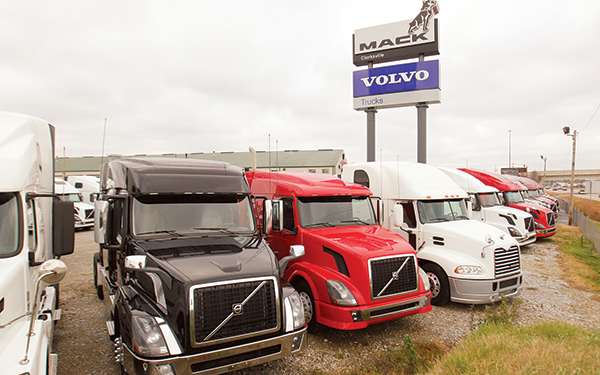Senior Reporter
Used Truck Market in July Underscores Buyers Are Leaving

[Stay on top of transportation news: Get TTNews in your inbox.]
Sales of used Class 8 trucks under $50,000 continued to fall during July, which helped drive up the average sales price, but at the same time underscored certain buyers have exited the market, according to ACT Research.
Sales of trucks priced below $50,000 have fallen 30% since the beginning of 2018, according to ACT.
“The hypothesis being, the buyers of less expensive trucks are going to be the marginal carriers who don’t get the phone call when freight slows down — owner-operators and smaller fleets,” ACT Vice President Steve Tam said. “The market is turning.”
Overall, used Class 8 sales in July slipped 6% to 21,500 compared with 23,000 a year earlier. Year-to-date, sales are off 11%, falling to 145,500 compared with 163,000.

Tam
ACT surveys a sample of dealers, wholesalers and auctioneers as well as a few large fleets to determine average prices, age and mileage, and volumes.
“I can tell you from what I hear from other dealers in that market is that Class 8 has slowed, and they are being very picky with what they buy,” said Amy Shahan, a buyer-seller of commercial trucks at Bayshore Ford Truck Sales in Newcastle, Del.
The average Class 8’s sales price increased 2% to $46,442 compared with $45,455 a year earlier. The peak year-over-year increase so far was 16% in April at $48,532.Year-to-date prices held up better, posting a 9% increase, but they are down from the peak year-to-date increase of 12% in June, when the price was $47,688.
“We expect to see that erosion [in pricing] continue, certainly through this year and into next year. I think prices will be down full-year 2020 over 2019. Whereas this year, we still have a shot at actually staying in positive territory,” Tam said.

In the meantime, the average Class 8 was older, 7 years, 1 month compared with 6 years, 10 months a year earlier. Mileage decreased to 433,000 compared with 448,000 in the 2018 period.
In a recent earnings call, J.B. Hunt Transport Services Inc. Chief Financial Officer David Mee noted that a truck maker the company buys from expressed concern recently that, while the market appears to have stabilized, October may be a key month for used trucks.
“They do expect, frankly, a change in the value depending on what does happen with the ultimate delivery of the inventory that they have at the dealers right now,” Mee said. “I think October was the next date that they were really trying to figure out what then do they do.”
Tam suggested that October could be when off-lease trucks come back on the market.
“That’s one of the things we’ve seen, as well, in this cycle, folks who were under lease contracts opted to extend those contracts because they were having a hard time getting new equipment and/or because they need to increase fleet size,” he added.
Paccar Inc. CEO Preston Feight agreed pricing was moderating but said the company, whose brands include Kenworth Truck Co. and Peterbilt Motors Co., was building a new used truck center in Denton, Texas. “We’ve watched our market share grow over the past several years.”
Asked by an analyst when a downturn in used truck sales could affect the profitability at Paccar’s financial services unit, Feight said that depended.
“I don’t think we kind of recalibrated into which quarter it would have an impact on, and obviously it depends a lot on the percent of retail versus wholesale [sales],” he said. “And our team is doing a really good job of selling a lot of used trucks in a retail position.”

Volvo and Mack trucks sit on the sales lot at Kentuckiana's Premier Truck Center in Clarksville, Ind. (John Sommers II for Transport Topics)
Meanwhile, Cummins Inc. reported the lifespan of aftertreatment systems — sometimes problematic and expensive equipment to replace and a key concern among used truck buyers — has improved on its older engines.
At the launch of its 2013 engine, the cleaning interval was 200,000 miles, using the same technology the company introduced in 2010.
“We had a separate diesel particulate filter, diesel oxidation catalyst and selective catalytic reduction [componentry],” Mark Ulrich, Cummins’ director of customer support, said during a Used Truck Association webinar in August.
For 2013 and 2014 engines built up until November 2014, customers can contact a Cummins certified repair location to schedule a calibration update.
Cummins extended the fixed interval for DPF cleaning in 2015 engines to 400,000 miles by improving its ability to estimate the ash load. Engines built after January 2016 have additional power cylinder improvements to allow up to a 500,000-mile interval.




